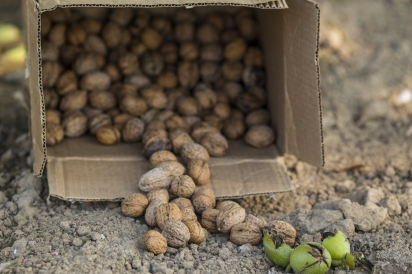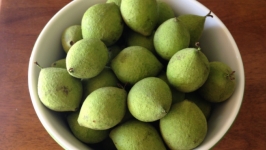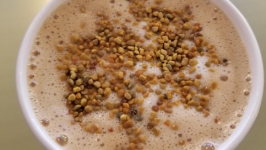Red Walnuts: A Nutty Pleasure of a Different Color
Bite into a red walnut from Idaho’s Bounty, an online co-op that connects growers with local consumers and restaurants and you’ll likely be transported to a quiet, shady orchard or a grove of gnarled trees. But the scarlet-skinned nuts probably don’t produce visions of two lone trees growing in Meridian.
Karoly Foldesi smiles beneath sandy, toweled-dry hair. His shorts reveal the legs of a professional soccer player, which he was in his native Hungary. As he nears 80, Foldesi spends less time working as a tool and die maker and more time growing traditional foods from his homeland. He used to create parts for military jets and T-rex–sized bolts for dinosaurs in Universal Studios’ Jurassic Park ride; now he tends a small European-style farm with crops, livestock and gardens.
On a visit back to Hungary, Foldesi and his late wife, Margaret, sampled colorful red walnuts with mild, creamy meat from a tree in a friend’s vineyard. In the late 1990s, Margaret tucked a few of those nuts into the soil beneath a potted lemon tree in their sunny atrium in Meridian. The seeds not only germinated, but thrived when Foldesi planted them outside. Before Margaret passed in 2011, she was able to enjoy the first two crops of red walnuts from the trees she had started a decade before.
The two smooth, gray-barked trees now tower over a tractor with its chest opened for surgery and trellises of Hungarian grapes from which Foldesi makes a dry wine. His youngest son, Robi, still shudders at the “hundreds and hundreds of pounds” of Hungarian peppers his father grew one year. The trees shade hens fleeing pursuing roosters, employees of Foldesi’s small egg business. Inside the trees’ wide crowns, broad branches near the ground invite climbing.
Red walnuts are a variant of the more common golden walnuts, or Juglans regia. (The black walnuts native to the Eastern United States are a related New World species called Juglans nigra.) The golden walnut’s appeal is reflected in the number of places that claim the nut. The California Walnut Commission has christened them “California walnuts” and the state produces most of the world’s supply. The British call them “English walnuts,” in a claim that predates California’s by 2,000 years.
But the nuts are more accurately “Persian walnuts,” as they are native to Central Asia. The mountains of Kyrgyzstan still shelter native walnut forests, which preserve the greatest remaining diversity of the species. Red walnut trees, which produce nuts with seedcoats ranging from pale mottled pink to deep purple, are scattered across Europe, where the nuts have been rediscovered and renamed many times. American researchers crossed a California golden walnut with a European red walnut to produce a red variety named Robert Livermore. People who have sampled both say the Livermore tastes more like a golden walnut, while Foldesi’s has a milder, creamier texture.
After a few harvests, Foldesi’s trees were producing more than he, his wife and their four grown sons could consume. So Foldesi convinced a local natural foods store to add his red walnuts to its shelves. There, they caught the eye of Cindy Compton, a teacher and local foods advocate. She was taken with the red walnut’s “crisp, clear flavor,” and bought enough for holiday gifts. The following year, Compton went straight to the source, collecting her red walnut haul directly from Foldesi’s farm. She finds them “gorgeous in cookies and bread” and delicious in a roasted beet salad with manchego cheese and arugula. Once Compton had satisfied her own red walnut cravings, she campaigned to make them available to others. She introduced Foldesi and Idaho’s Bounty to one another
Before the fall harvest, Foldesi props up the branches of his trees to support the weight of the ripening crop. The trees sag under the responsibility of producing all the red walnuts for the Treasure Valley. The scarlet nuts are available in time for Thanksgiving and the holidays, but Idaho’s Bounty quickly sells out of the nuts, which are as evanescent as they are mysterious. Foldesi and son Robi have started more trees to expand production. In a decade, nut lovers might correctly taste a thriving grove of red walnut trees when they bite into the colorful kernels.












